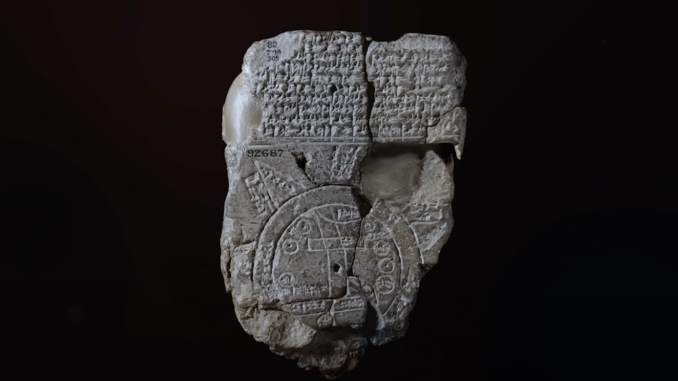Peloni: Fascinating: an ancient map reveals location of Noah’s ark.
Points to Noah’s Ark Spot, Archeologists Say
Talia Wise | CBN | November 1, 2024
Scientists have finally deciphered an ancient Babylonian artifact and say its inscription points to the location of Noah’s Ark.
It has taken years to uncover the meaning of a 3,000-year-old clay tablet known as the Imago Mundi.
“This is the oldest map of the world, in the world,” said Dr. Irving Finkel, a British Museum curator and cuneiform expert.
The artifact has a script with wedge-shaped symbols called cuneiform and archeologists have been stumped for years as to its meaning.
But after months of intensive study, scientists now believe the carvings make clear references to the Bible.
“It has two sides, this is the front or ‘obverse’ and this is the back or the ‘reverse’ and the reverse consists of lots of lines of cuneiform in different ruled sections,” explained Finkel. “So it’s full of information, even though it’s a bit damaged.”
Finkel notes that the map shows ancient Mesopotamia, which is modern-day Iraq, surrounded by the “Bitter River.” The river represented by a double ring indicates the border of the Babylonians’ known world.
“This is a very important ring of water because it meant for the Babylonians, they had a sort of idea of the limits of their world where they lived in about the 6th century BC,” he said.
The map also contained a secret key to show travelers the route on the water they should take and what to look out for while on the way.
Finkel shares that one of the passages instructs travelers to go through “seven leagues to see something that is thick as a parsiktu-vessel.”
The term “parsiktu” is used to reference the size of a vessel needed to survive a great flood.
Then, Finkel notes, the artifact refers to “Urartu” and specific instructions on how to get there.
“To the fourth, to which you must travel seven leagues,” it reads.
Researchers believe that “Urartu”, which is also known as Ararat, is linked to an ancient Mesopotamian poem about a man and his family who landed an ark following a 150-day flood.
“The first place you come to is called ‘Urartu’, it’s drawn on the map. Now, the interesting thing about that is that in the Bible Noah, in his Ark, landed on a mountain where the name is ‘Ararat’ and ‘Ararat’ is the Hebrew equivalent of the Assyrian ‘Urartu’. That’s quite a meaty thing, quite an interesting thing to think about because it shows that the story was the same, and of course that one led to the other but also, that from the Babylonian point of view, this was a matter of fact thing,” said Finkel.
He added, “If you did go on this journey, you would see the remnants of this historic boat which saved all the life of the world for the long-term future.”
The Babylonian version of the story closely follows the Biblical account of Noah’s Ark.
“In this account, the details are given and the God says ‘You have to do this, this and this’ and then the Babylonian Noah says ‘I did this, this and this. I’ve done it!’ ” Finkel explained. “And I made these structures as thick parsiktu vessel.”
According to the Babylonian version, the man fills his vessel with animals and ends up safely stationed at one of the peaks of Urartu, known as modern-day Turkey, after the flood.
“So, for the first time we can pronounce with authority, that if we were an ancient Babylonian we would know where to go to see the remains of that wonderful boat,” said Finkel.
Some researchers question whether the structure in Turkey is natural or created.
Dr. Andrew Snelling, a geologist from the University of Sydney who has studied the flood, previously said that Mount Ararat could not be the ark’s location, stating that the mountain did not form until after the flood waters receded, the Jerusalem Post noted.
The Babylonian artifact was discovered in the Middle East and was acquired by the British Museum in 1882, where it is currently on display.




Thanks for posting this video. It was a gem. I loved learning about the process involved in finding a small section of the cuneiform map that when fitted with the whole map gave great clues.
I have always wondered how the Babylonians thought about the world and how they pictured their place in the world.
What was especially interesting was that on the reverse of the tablet are very small cuneiform words that tell the story that the map on the obverse side depicts in images.
Watching the video was like an adventure.
I then watched a related video, the process of making an ark according to the cuneiform tablet’s instructions. Once again, another adventure!